Related Research Articles

In mathematics, graph theory is the study of graphs, which are mathematical structures used to model pairwise relations between objects. A graph in this context is made up of vertices which are connected by edges. A distinction is made between undirected graphs, where edges link two vertices symmetrically, and directed graphs, where edges link two vertices asymmetrically. Graphs are one of the principal objects of study in discrete mathematics.
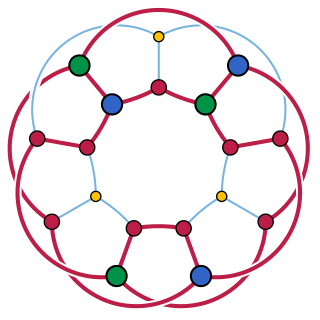
In graph theory, Kuratowski's theorem is a mathematical forbidden graph characterization of planar graphs, named after Kazimierz Kuratowski. It states that a finite graph is planar if and only if it does not contain a subgraph that is a subdivision of or of .

In graph theory, an isomorphism of graphsG and H is a bijection between the vertex sets of G and H
Informally, the reconstruction conjecture in graph theory says that graphs are determined uniquely by their subgraphs. It is due to Kelly and Ulam.
This is a glossary of graph theory. Graph theory is the study of graphs, systems of nodes or vertices connected in pairs by lines or edges.
In the mathematical discipline of graph theory, the line graph of an undirected graph G is another graph L(G) that represents the adjacencies between edges of G. L(G) is constructed in the following way: for each edge in G, make a vertex in L(G); for every two edges in G that have a vertex in common, make an edge between their corresponding vertices in L(G).

In graph theory, a critical graph is an undirected graph all of whose proper subgraphs have smaller chromatic number. In such a graph, every vertex or edge is a critical element, in the sense that its deletion would decrease the number of colors needed in a graph coloring of the given graph. The decrease in the number of colors cannot be by more than one.
In graph theory, the strong perfect graph theorem is a forbidden graph characterization of the perfect graphs as being exactly the graphs that have neither odd holes nor odd antiholes. It was conjectured by Claude Berge in 1961. A proof by Maria Chudnovsky, Neil Robertson, Paul Seymour, and Robin Thomas was announced in 2002 and published by them in 2006.
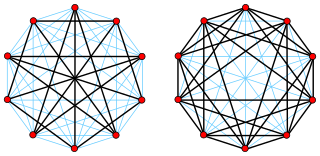
In the mathematical field of graph theory, the complement or inverse of a graph G is a graph H on the same vertices such that two distinct vertices of H are adjacent if and only if they are not adjacent in G. That is, to generate the complement of a graph, one fills in all the missing edges required to form a complete graph, and removes all the edges that were previously there.
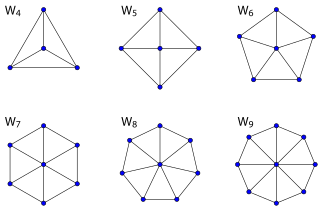
In the mathematical discipline of graph theory, a wheel graph is a graph formed by connecting a single universal vertex to all vertices of a cycle. A wheel graph with n vertices can also be defined as the 1-skeleton of an (n – 1)-gonal pyramid. Some authors write Wn to denote a wheel graph with n vertices ; other authors instead use Wn to denote a wheel graph with n + 1 vertices, which is formed by connecting a single vertex to all vertices of a cycle of length n. The rest of this article uses the former notation.
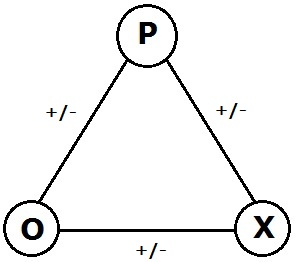
In the area of graph theory in mathematics, a signed graph is a graph in which each edge has a positive or negative sign.

In graph theory, a factor of a graph G is a spanning subgraph, i.e., a subgraph that has the same vertex set as G. A k-factor of a graph is a spanning k-regular subgraph, and a k-factorization partitions the edges of the graph into disjoint k-factors. A graph G is said to be k-factorable if it admits a k-factorization. In particular, a 1-factor is a perfect matching, and a 1-factorization of a k-regular graph is a proper edge coloring with k colors. A 2-factor is a collection of cycles that spans all vertices of the graph.

In graph theory, a circulant graph is an undirected graph acted on by a cyclic group of symmetries which takes any vertex to any other vertex. It is sometimes called a cyclic graph, but this term has other meanings.

In graph theory, a mathematical discipline, a factor-critical graph is a graph with n vertices in which every subgraph of n − 1 vertices has a perfect matching.
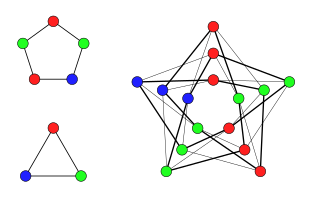
In graph theory, Hedetniemi's conjecture, formulated by Stephen T. Hedetniemi in 1966, concerns the connection between graph coloring and the tensor product of graphs. This conjecture states that
In graph theory, Vizing's conjecture concerns a relation between the domination number and the cartesian product of graphs. This conjecture was first stated by Vadim G. Vizing (1968), and states that, if γ(G) denotes the minimum number of vertices in a dominating set for the graph G, then

In mathematics, and more specifically in graph theory, a directed graph is a graph that is made up of a set of vertices connected by directed edges, often called arcs.

In geometric graph theory, a branch of mathematics, a polyhedral graph is the undirected graph formed from the vertices and edges of a convex polyhedron. Alternatively, in purely graph-theoretic terms, the polyhedral graphs are the 3-vertex-connected, planar graphs.

In graph theory, a caterpillar or caterpillar tree is a tree in which all the vertices are within distance 1 of a central path.

In the mathematical study of graph theory, a pancyclic graph is a directed graph or undirected graph that contains cycles of all possible lengths from three up to the number of vertices in the graph. Pancyclic graphs are a generalization of Hamiltonian graphs, graphs which have a cycle of the maximum possible length.
References
- ↑ Harary, Frank (1969), Graph Theory, Reading, Mass.: Addison-Wesley, MR 0256911 .
- ↑ Harary, Frank (1964), "On the reconstruction of a graph from a collection of subgraphs", in Fiedler, M. (ed.), Theory of Graphs and its Applications (Proc. Sympos. Smolenice, 1963), Publ. House Czechoslovak Acad. Sci., Prague, pp. 47–52, MR 0175111
- 1 2 Stockmeyer, Paul K. (1977), "The falsity of the reconstruction conjecture for tournaments", Journal of Graph Theory , 1 (1): 19–25, doi:10.1002/jgt.3190010108, MR 0453584 . Erratum, J. Graph Th.62 (2): 199–200, 2009, doi : 10.1002/jgt.20398, MR 2555098.
- ↑ Stockmeyer, Paul K. (1981), "A census of nonreconstructible digraphs. I. Six related families", Journal of Combinatorial Theory , Series B, 31 (2): 232–239, doi:10.1016/S0095-8956(81)80027-5, MR 0630985 .
- ↑ Stockmeyer, Paul K. (1991), A census of nonreconstructible digraphs II: A family of tournaments, Preprint.
- ↑ Ramachandran, S. (1979), "A digraph reconstruction conjecture", Graph Theory Newsletter, 8 (4), Western Michigan University.
- ↑ Ramachandran, S. (1981), "On a new digraph reconstruction conjecture", Journal of Combinatorial Theory , Series B, 31 (2): 143–149, doi: 10.1016/S0095-8956(81)80019-6 , MR 0630977 .
- ↑ Ramachandran, S; Monikandan, S (2006), "All Digraphs are N-reconstructible if all Digraphs with 2-connected underlying Graphs are N-reconstructible", Utilitas Mathematica, 71, UTIL MATH PUBL INC: 225–234, MR 2278835
- ↑ Ramachandran, S (2012), "Sufficient Conditions For The N-Reconstructibility Of All Digraphs", Utilitas Mathematica, 88, UTIL MATH PUBL INC: 183–188, MR 2975831